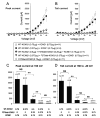A novel mutation in KCNQ1 associated with a potent dominant negative effect as the basis for the LQT1 form of the long QT syndrome
- PMID: 17655673
- PMCID: PMC2085492
- DOI: 10.1111/j.1540-8167.2007.00889.x
A novel mutation in KCNQ1 associated with a potent dominant negative effect as the basis for the LQT1 form of the long QT syndrome
Abstract
Introduction: Long QT Syndrome (LQTS) is an inherited disorder characterized by prolonged QT intervals and life-threatening polymorphic ventricular tachyarrhythmias. LQT1 caused by KCNQ1 mutations is the most common form of LQTS.
Methods and results: Patients diagnosed with LQTS were screened for disease-associated mutations in KCNQ1, KCNH2, KCNE1, KCNE2, KCNJ2, and SCN5A. A novel mutation was identified in KCNQ1 caused by a three-base deletion at the position 824-826, predicting a deletion of phenylalanine at codon 275 in segment 5 of KCNQ1 (DeltaF275). Wild-type (WT) and DeltaF275-KCNQ1 constructs were generated and transiently transfected together with a KCNE1 construct in CHO-K1 cells to characterize the properties of the slowly activating delayed rectifier current (IKs) using conventional whole-cell patch-clamp techniques. Cells transfected with WT-KCNQ1 and KCNE1 (1:1.3 molar ratio) produced slowly activating outward current with the characteristics of IKs. Tail current density measured at -40 mV following a two-second step to +60 mV was 381.3 +/- 62.6 pA/pF (n = 11). Cells transfected with DeltaF275-KCNQ1 and KCNE1 exhibited essentially no current. (Tail current density: 0.8 +/- 2.1 pA/pF, n = 11, P = 0.00001 vs WT). Cotransfection of WT- and DeltaF275- KCNQ1 (50/50), along with KCNE1, produced little to no current (tail current density: 10.3 +/- 3.5 pA/pF, n = 11, P = 0.00001 vs WT alone), suggesting a potent dominant negative effect. Immunohistochemistry showed normal membrane trafficking of DeltaF275-KCNQ1.
Conclusion: Our data suggest that a DeltaF275 mutation in KCNQ1 is associated with a very potent dominant negative effect leading to an almost complete loss of function of IKs and that this defect underlies a LQT1 form of LQTS.
Figures






Similar articles
-
Overlapping LQT1 and LQT2 phenotype in a patient with long QT syndrome associated with loss-of-function variations in KCNQ1 and KCNH2.Can J Physiol Pharmacol. 2010 Dec;88(12):1181-90. doi: 10.1139/Y10-094. Can J Physiol Pharmacol. 2010. PMID: 21164565 Free PMC article.
-
LQT1 mutations in KCNQ1 C-terminus assembly domain suppress IKs using different mechanisms.Cardiovasc Res. 2014 Dec 1;104(3):501-11. doi: 10.1093/cvr/cvu231. Epub 2014 Oct 24. Cardiovasc Res. 2014. PMID: 25344363 Free PMC article.
-
A molecular mechanism for adrenergic-induced long QT syndrome.J Am Coll Cardiol. 2014 Mar 4;63(8):819-27. doi: 10.1016/j.jacc.2013.08.1648. Epub 2013 Oct 30. J Am Coll Cardiol. 2014. PMID: 24184248
-
Insights into Cardiac IKs (KCNQ1/KCNE1) Channels Regulation.Int J Mol Sci. 2020 Dec 11;21(24):9440. doi: 10.3390/ijms21249440. Int J Mol Sci. 2020. PMID: 33322401 Free PMC article. Review.
-
The rate-dependent biophysical properties of the LQT1 H258R mutant are counteracted by a dominant negative effect on channel trafficking.J Mol Cell Cardiol. 2010 Jun;48(6):1096-104. doi: 10.1016/j.yjmcc.2009.10.027. Epub 2009 Nov 11. J Mol Cell Cardiol. 2010. PMID: 19913547 Review.
Cited by
-
Novel mechanisms of trafficking defect caused by KCNQ1 mutations found in long QT syndrome.J Biol Chem. 2009 Dec 11;284(50):35122-33. doi: 10.1074/jbc.M109.017293. Epub 2009 Oct 13. J Biol Chem. 2009. PMID: 19825999 Free PMC article.
-
Genetics of channelopathies associated with sudden cardiac death.Glob Cardiol Sci Pract. 2015 Oct 13;2015(3):39. doi: 10.5339/gcsp.2015.39. eCollection 2015. Glob Cardiol Sci Pract. 2015. PMID: 26566530 Free PMC article. Review.
-
Retroinverso analogs of spadin display increased antidepressant effects.Psychopharmacology (Berl). 2015 Feb;232(3):561-74. doi: 10.1007/s00213-014-3683-2. Epub 2014 Aug 2. Psychopharmacology (Berl). 2015. PMID: 25080852 Free PMC article.
-
Uses of cardiomyocytes generated from induced pluripotent stem cells.Stem Cell Res Ther. 2011 Nov 18;2(6):44. doi: 10.1186/scrt85. Stem Cell Res Ther. 2011. PMID: 22099214 Free PMC article. Review. No abstract available.
-
Enhanced effects of isoflurane on the long QT syndrome 1-associated A341V mutant.Anesthesiology. 2015 Apr;122(4):806-20. doi: 10.1097/ALN.0000000000000583. Anesthesiology. 2015. PMID: 25585005 Free PMC article.
References
-
- Roden DM. Long QT syndrome: reduced repolarization reserve and the genetic link. J Intern Med. 2006;259:59–69. - PubMed
-
- Moss AJ, Zareba W, Benhorin J, Locati EH, Hall WJ, Robinson JL, Schwartz PJ, Towbin JA, Vincent GM, Lehmann MH, Keating MT, MacCluer JW, Timothy KW. ECG T-wave patterns in genetically distinct forms of the hereditary long QT syndrome. Circulation. 1995;92:2929–2934. - PubMed
-
- Zhang L, Timothy KW, Vincent GM, Lehmann MH, Fox J, Giuli LC, Shen J, Splawski I, Priori SG, Compton SJ, Yanowitz F, Benhorin J, Moss AJ, Schwartz PJ, Robinson JL, Wang Q, Zareba W, Keating MT, Towbin JA, Napolitano C, Medina A. Spectrum of ST-T-wave patterns and repolarization parameters in congenital long-QT syndrome: ECG findings identify genotypes. Circulation. 2000;102:2849–2855. - PubMed
-
- Schulze-Bahr E, Haverkamp W, Wiebusch H, Schulte H, Hordt M, Borggrefe M, Breithardt G, Assmann G, Funke H. Molecular analysis at the Harvey Ras-1 gene in patients with long QT syndrome. J Mol Med. 1995;73:565–569. - PubMed
Publication types
MeSH terms
Substances
Grants and funding
LinkOut - more resources
Full Text Sources
Miscellaneous

